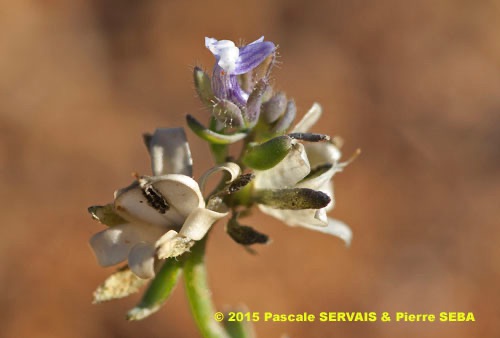
Linaria micrantha (Cav.) Hoffmanns. & Link
Fam. : Scrophulariaceae
© Pascale SERVAIS & Pierre SEBA, 2018. Tilo Botanica: Flore de Tilos et du Dodécanèse / Flora of Tilos and of the Dodecanese
English translation by Brenda Bradbury, Howard Bradbury and Stéphane Léonard
Plante herbacée, hermaphrodite, à tiges assez épaisses, dressées, ramifiées, glabres, glauques, rougeâtres à la base, feuillées sur toute la longueur.
Feuilles de la base verticillées par 3, les supérieures alternes, simples, linéaires à lancéolées ou oblongues, obtuses, de 5 à 10 mm de long, entières, glabres.
Fleurs à symétrie bilatérale, bleu clair à lilas, veinées de mauve plus foncé, de 4 à 7 mm de long, à 2 lèvres, la supérieure bilobée, l’inférieure trilobée, aux renflements de la gorge blancs striés de mauve, réunies en courtes grappes de 7 à 9 mm de long. Chaque fleur portée par un pédicelle de 1 à 2 mm de long, beaucoup plus court que le calice, s’allongeant à la fructification. Éperon droit ou à peine arqué, de 1 à 1,5 mm de long, presque réduit à une minuscule bosse conique, plus court que l’ovaire. Calice à 5 sépales linéaires à oblongs, à poils glanduleux, vert un peu rougeâtre, à peine plus courts que la corolle. Ovaire supère.
Fruits, petites capsules vertes, de 3 à 4 mm de diamètre, glabres, sphériques, égales ou à peine plus courtes que les calices persistants qui les entourent. Graines grisâtres, verruqueuses, de 1,5 à 2 mm de diamètre, bordées tout autour d’une aile large.
___________________________
Plant herbaceous, hermaphrodite. Stems rather thick, erect, branched, glabrous, glaucous, reddish at the base, leafy over all the length.
Leaves of the base whorled by 3, the higher ones alternate, simple, linear to lanceolate or oblong, blunt, from 5 to 10 mm long, entire, glabrous.
Flowers bilaterally symmetrical, pale blue to lilac, with darkest mauve veins, from 4 to 7 mm long, two-lipped, the higher lip two-lobed, the lower one three-lobed, with swellings of the throat white covered in mauve ridges, joined together in short racemes from 7 to 9 mm long. Each flower carried by a pedicel from 1 to 2 mm long, much shorter than the calyx, lengthening at fructification. Spur straight or scarcely curved, from 1 to 1.5 mm long, almost reduced to a tiny, conical hump, shorter than the ovary. Calyx with 5 linear to oblong sepals, with glandulous hairs, a little reddish green, scarcely shorter than the corolla. Ovary superior.
Fruits, small green capsules, from 3 to 4 mm in diameter, glabrous, spherical, equal to or scarcely shorter than the persistent calyxes which surround them. Seeds greyish, verrucose, from 1.5 to 2 mm in diameter, bordered all around by a wide wing.
Descripteurs / Identifying features
1
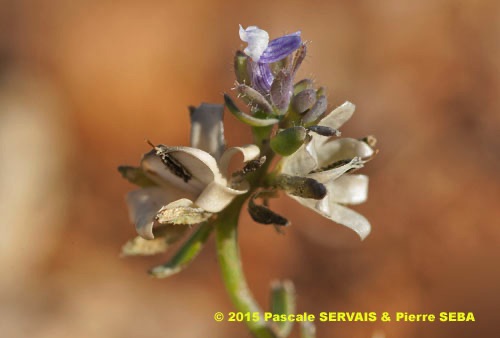
2
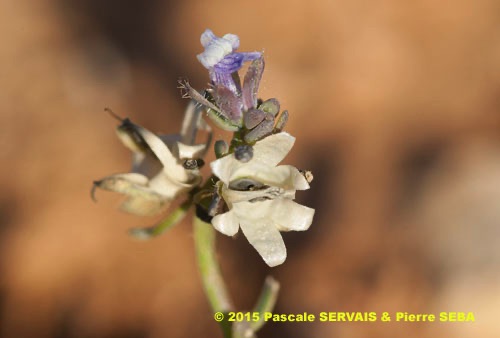
3
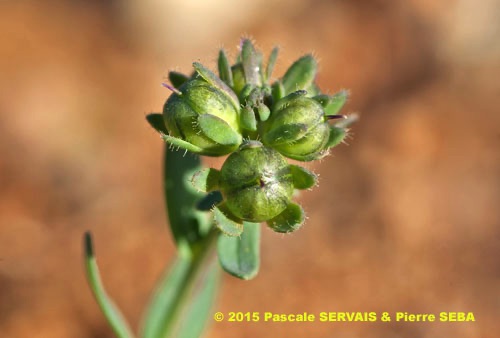
4

5
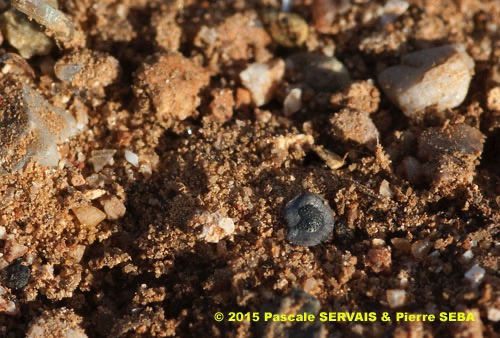
6
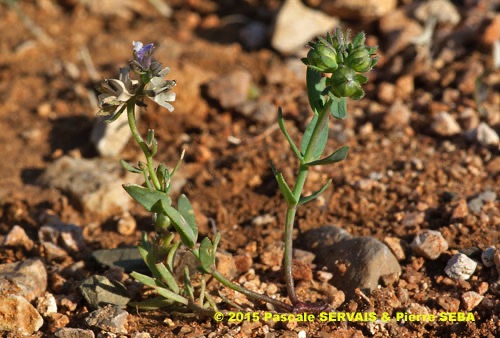
7
Étymologie / Etymology :
Linaria : emprunt du latin linum, -i (nom) = le lin (plante et tissu),
forme latinisée du grec ancien λίνον, -ου (nom) = le lin (plante et
tissu), en référence aux feuilles semblables à celles du lin.
Micrantha : adjectif créé par les botanistes [ < μικρός, -ά, -όν (adj.)
= petit + ἄνθος, -ους (nom) = la fleur ] = qui a de petites fleurs.
Linaria : borrowed from Latin linum, -i (noun) = flax (plant and cloth),
Latinized form of the Classical Greek λίνον, -ου (noun) = flax (plant
and cloth), referring to the leaves similar to those of the flax.
Micrantha : adjective created by botanists [ < μικρός, -ά, -όν (adj)
= small + ἄνθος, -ους (noun) = flower ] = which has small flowers.
Synonymes / Synonyms :
Antirrhinum micranthum Cav.
Linaria arvensis subsp. micrantha (Cav.) P.Fourn.
Linaria arvensis subsp. parviflora (Desf.) Rouy
Linaria parviflora Desf.
Noms vernaculaires / Common names :
Nom français / French name :
Linaire à petites fleurs.
Nom anglais / English name :
Small-leaved toadflax.
Nom allemand / German name :
Kleinblättriges Leinkraut.
Nom espagnol / Spanish name :
Linaria de flor enana.
Nom italien / Italian name :
Linajola minima.
Habitat :
Cultures - Lieux pierreux - Lieux incultes - Murs, rochers.
Cultivated places - Stony places - Waste ground - Walls, rocks.
Île / Island :
Tilos.
Hauteur / Height range :
De 5 cm à 10 cm.
From 5 cm to 10 cm.
Floraison / Flowering time :
De février à avril.
From February to April.
Groupe / Classification :
Dicotylédones.
Dicotyledons.
Pérennité / Lifespan :
Annuelle.
Annual.
Description :
Clés dichotomiques et descripteurs distinctifs des 4 espèces / Dichotomous keys and distinctive identifying features of the 4 species
Photo 1 :
Localisation / Location : Tilos, Livadia, Route de Chyta
Date : 03/03/2015
GPS : Lat. 36,40350° N / Long. 27,37827° E / Alt. 189 m
Type : Photographie numérique / Digital Photograph (10 mégapixels)
Photo 2 :
Localisation / Location : Tilos, Livadia, Route de Chyta
Date : 03/03/2015
GPS : Lat. 36,40350° N / Long. 27,37827° E / Alt. 189 m
Type : Photographie numérique / Digital Photograph (10 mégapixels)
Photo 3 :
Localisation / Location : Tilos, Livadia, Route de Chyta
Date : 03/03/2015
GPS : Lat. 36,40350° N / Long. 27,37827° E / Alt. 189 m
Type : Photographie numérique / Digital Photograph (10 mégapixels)
Photo 4 :
Localisation / Location : Tilos, Livadia, Route de Chyta
Date : 03/03/2015
GPS : Lat. 36,40350° N / Long. 27,37827° E / Alt. 189 m
Type : Photographie numérique / Digital Photograph (10 mégapixels)
Photo 5 :
Localisation / Location : Tilos, Livadia, Route de Chyta
Date : 03/03/2015
GPS : Lat. 36,40350° N / Long. 27,37827° E / Alt. 189 m
Type : Photographie numérique / Digital Photograph (10 mégapixels)
Photo 6 :
Localisation / Location : Tilos, Livadia, Route de Chyta
Date : 03/03/2015
GPS : Lat. 36,40350° N / Long. 27,37827° E / Alt. 189 m
Type : Photographie numérique / Digital Photograph (10 mégapixels)
Photo 7 :
Localisation / Location : Tilos, Livadia, Route de Chyta
Date : 03/03/2015
GPS : Lat. 36,40350° N / Long. 27,37827° E / Alt. 189 m
Type : Photographie numérique / Digital Photograph (10 mégapixels)

Google Maps
Google Maps
Google Maps
Google Maps
Google Maps
Google Maps
Google Maps